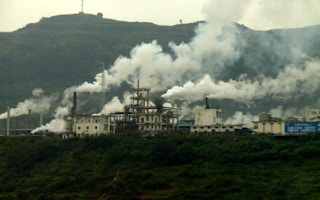All the pieces are in place for China to step forward as a global climate leader, but the country’s next steps could determine whether its ambitious targets bring about substantive change or fade away into greenwashing.
“When our government says something, it is something that has to be achieved,” Beijing’s senior climate advisor Wang Zhongying told Carbon Brief, in a rare interview where he described how China is seriously pursuing its climate policy — framed in two documents submitted to the United Nations last October.
One of them is a revised 2030 pledge that confirmed the country would peak carbon dioxide emissions before 2030 and achieve net zero emissions by 2060. The second document is a long-term strategy (LTS) on how to get there.
Both documents were met with international disappointment when they were released. However, experts say that if these are fully implemented, they could lead China to achieve a lower emissions peak ahead of schedule, said Carbon Brief.
The pledge and LTS set out concrete targets like “reducing carbon dioxide emissions per unit of gross domestic product (GDP) by more than 65 per cent from 2005 levels” and “increasing the share of energy from renewable sources from 25 per cent to 80 per cent”. However, there are road bumps ahead. These include not only “the technical challenges of turning away from its heavy reliance on coal and rapidly scaling up replacement clean energy, but also the need to balance sometimes competing priorities in terms of economic growth, social cohesion, and international relations,” Carbon Brief explained.
The country will also need to develop national standards or mechanisms to crack down on dubious claims of carbon neutrality, as growing climate awareness in China is accompanied by “unprecedented levels of hype and greenwashing,” reported Bloomberg. Though many products are being marketed as carbon neutral, companies are not following up with information to verify emissions or offsets.
“To unify the crediting and verification system will be the next step to go for China,” said Qin Yan, lead carbon analyst at Refinitiv. “The Chinese way is top-down and it relies on administrative regulations, while in Europe there is supervision from independent groups, and the media often calls out companies’ greenwashing behaviours.”
For instance, Chinese oil and gas producers are able to establish carbon neutrality plans for their operations without addressing emissions from the fuel being consumed, and companies are using the term “clean coal” to try to justify investments in the offensive fuel. Poor regulation could get in the way of reaching climate targets, Bloomberg said, if companies can get away with carbon neutrality plans that are only “vague promises rather than concrete measures.”
Still, Chinese leaders do seem to be taking the matter seriously. Climate goals were emphasised during China’s highest-level economic planning meeting in December, where leaders also “called on the country to ‘correctly recognise and understand’ five ‘new major theoretical and practical issues,’ which included the goals of carbon peaking and carbon neutrality,” reported Carbon Brief.
There have also been encouraging improvements to air quality in Beijing, contrary to the doubts of pessimistic residents. Strong emissions standards and control technologies applied to high-emitting industries, the elimination of coal-based heating and cooking at the home and district levels, and a slowdown in coal consumption growth since 2013 all helped the city meet national air quality targets in 2021 for the first time. Strong incentives for governments to sustain the improvements, and public expectations that they do so, indicate that the progress marks real change, the Center for Research on Energy and Clean Air said.
If China can overcome its challenges and maintain this momentum, it has an opportunity to emerge as a world leader on climate, especially as other countries make compromises and lag behind. The European Union, China, Russia, and South Korea have all recently drafted green taxonomies to facilitate sustainable investing. However, both South Korea and the EU have bowed to politics and lobbying by including gas in their taxonomies, giving green investors a go-ahead to put money in gas despite its high methane and carbon emissions, reported the Institute for Energy Economics and Financial Analysis (IEEFA).
China, however, has so far held the line to exclude gas, a move that could put the country in a better position to fulfill its climate commitments. The taxonomy will also help form the green finance system to drive China’s transition beyond the capacity of government funds.
“Capital providers around the world are urging governments to step up and commit to clear, strong, and investable policies that will unlock the capital needed to transition to a net-zero economy,” said the IEEFA. “China has a lot to be proud of with its green taxonomy..and if it remains strategic, China could see private capital mobilised expeditiously to plug its energy transition financing gap.”
This story was published with permission from The Energy Mix.

















